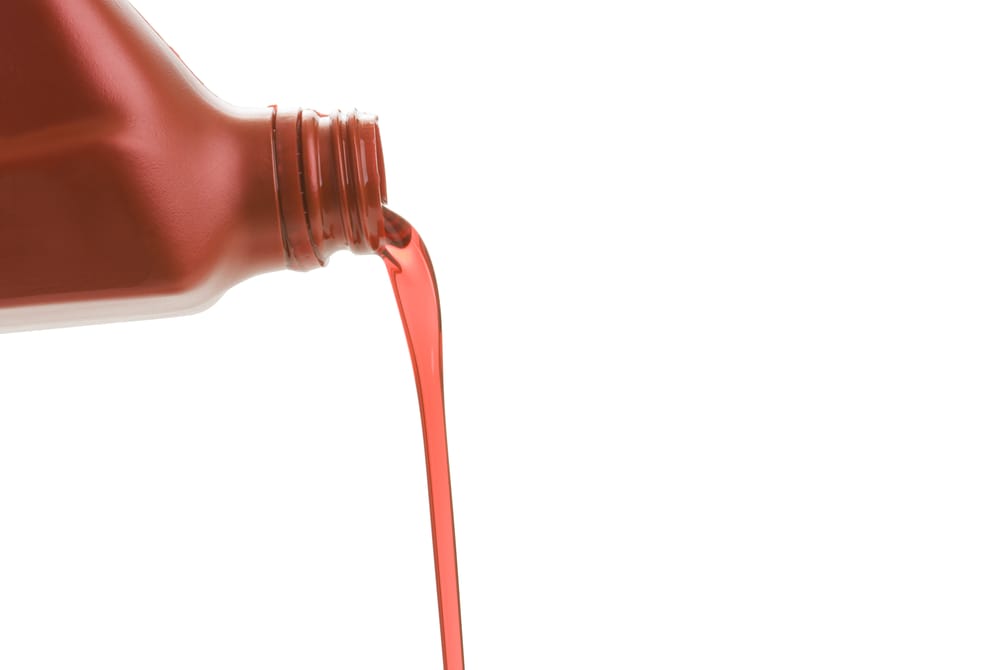Historically, before synthetic engine oils, mechanics and car owners added
transmission fluid to an engine's motor oil to clean the engine's internals
of carbon build-up, but is it still safe to put transmission oil in today's
engines?
Adding a small amount of transmission fluid to engine oil will not
negatively affect the motor oil's ability to lubricate and cool the
engine as long as the transmission fluid is manufactured from the same
base oil as the engine's oil.
However, adding large amounts of transmission fluid will significantly
change the motor oil's chemical composition and, by extension, its
ability to properly cool and lubricate the engine, possibly leading to
catastrophic engine damage.
Below we go over some of the properties of both engine oil and transmission
fluid and why you shouldn't add transmission fluid to your engine's oil.
 Adding transmission fluid to an engine will most likely cause damage.
Adding transmission fluid to an engine will most likely cause damage.
Is Transmission Fluid And Engine Oil The Same?
No, transmission fluid and engine oil are not the same. Transmission
oil is formulated to provide the hydraulic pressure necessary to shift
the gears in the transmission. In contrast, engine oil is designed to
fulfill its primary purpose of reducing friction between the metal
surfaces in the internal combustion engine.
Here is how motor oil and transmission fluid differ from each other:
Appearance
Motor oil initially starts with a honey-like amber appearance but becomes
darker as it circulates through the engine due to high heat and the
contaminants present inside the engine.
Transmission fluid ranges from red to green in color. For example,
automatic Transmission Fluid (ATF) is red, Manual Transmission Fluid is
usually dark green, while Continuously Variable Transmission (CVT) fluid is
green and translucent.
Purpose
Engine oil is designed to serve several purposes.
-
Cools the engine
by circulating through the engine and transferring heat to the oil pan.
-
Prevents corrosion
by keeping the engine's internals coated with a thin layer of oil.
-
Prevents wear
by providing lubrication between the moving metal surfaces inside the
engine.
-
Helps create a seal between the piston rings and cylinder bore
to keep the combustion process isolated to the combustion chamber.
-
Reduces sludge, deposits, and build-up
due to the detergents and other additives formulated into the motor
oil.
Transmission fluid also serves similar purposes but for the transmission
rather than the engine.
-
Provides pressure
to actuate the transmission's internal mechanisms to shift gears.
-
Lubricates the gears, clutches, and supporting components
to keep them moving smoothly.
-
Cools the transmission
by circulating through the transmission cooler.
-
Prevents corrosion
by coating the components with an oily layer to protect them from
moisture.
Lifespan
You should check your vehicle's owner's manual to determine how many miles
it can run before it needs engine oil and transmission fluid change.
Engine oil has a shorter lifespan. Usually, it has to be replaced after
your car has driven a distance of 3,000 to 6,000 miles. If you don't
replace it, the old oil will have a negative impact on your engine's
performance.
Transmission oil, on the other hand, lasts longer. Typically, you don't
have to change it before your vehicle has traveled 30,000 to 60,000 miles.
ATF lasts even longer. You can drive up to 100,000 miles before changing
it.
 The engine oil should be changed if transmission fluid is added.
The engine oil should be changed if transmission fluid is added.
What Happens If You Accidentally Put Transmission Fluid In Your Oil?
You could have a big problem if you accidentally put transmission fluid
in your engine oil, but it depends on how much transmission fluid you
added and the transmission fluid's composition.
The probability of damage if you run the engine with the mixed oils is less
If the transmission fluids base oil is the same as the engine oils.
However, you should change out the mixed oil for new engine oil as soon as
possible and without starting the engine.
Some different ways transmission fluid can affect the motor's engine oil
are:
1. Reduces Cleaning Power
Motor oils contain additives such as detergents that clean the engine's
internals.
Transmission fluid may interfere with the detergent's ability to do its
job.
2. Lowers Wear Protection
Motor oils are formulated to lubricate the various moving parts rubbing
against one another inside the engine.
While transmission oil is designed to lubricate, it is not intended to
lubricate at an engine's high temperatures, leading to excessive engine
wear.
3. Makes Engine Oil More Viscous
Engine oil must flow easily to get where it needs to be to provide
protection. This is particularly important when starting a cold engine.
Transmission fluid may increase the engine oil's viscosity, hampering its
ability to flow and provide the protection it needs.
Can You Mix Transmission Fluid With Oil?
You should avoid mixing transmission fluid with oil.
There was a time when car owners used to mix transmission fluid in their
motor oil to rid their engines of the sludge and build-up. But the oils we
use nowadays have a superior cleaning ability than transmission fluid. If
anything, mixing transmission fluid with engine oil will reduce the oil's
efficiency.
If you have mixed transmission fluid with engine oil but have not started
your engine yet, you can drain the mixture out.
Can Engine Oil Get Into Transmission?
No, engine oil cannot get into the transmission.
Various seals and bell housing isolate the engine oil and transmission oil.
The only way engine oil can get into the transmission is when it is
mistakenly poured there instead of the transmission fluid, which is why you
should always double-check the labels of the fluids before putting any in
your car.
Conclusion
Transmission fluid and motor oil are formulated differently.
They may share some purposes but are designed to service two separate
components of a car.
There was a time when people put transmission fluid in the oil to flush
their engine.
These days you have dedicated engine flushing products that can take care
of the sludge and deposits in your engine.
If you have mixed transmission fluid with engine oil or vice versa, drain
the mixture before starting the car.